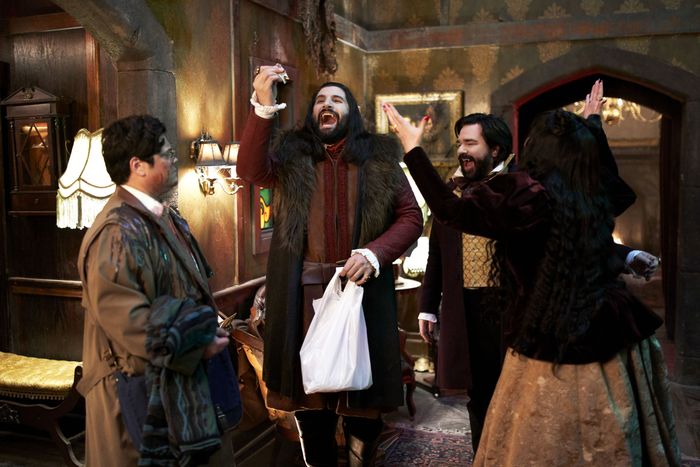
My favorite comedies tend to share an underlying ideology. They often begin with a very dumb idea — American Vandal’s spray-painted dicks, for instance — and then they take that idea very, very seriously. It is a Venn diagram of my most beloved TV preferences: goofiness combined with intense thought, looseness hammered down into a painstakingly perfect story. If I were just a half-step more pretentious, I’d probably call it “silly TV jazz” or something equally obnoxious.
There aren’t that many comedies like this. There’s the happily revived Tuca & Bertie, and there are elements of it in the way Superstore takes a mundane, often-dismissed setting and makes it revelatory. But the best very dumb, very serious show on TV right now is What We Do in the Shadows.
The silliness in this show is visible right on the surface. It’s about four vampires who live together in a big Gothic mansion on Staten Island. That premise alone creates a lovely combination of roommate politics, vampire logistics, Staten Island, and the interpersonal dynamics of four individuals who in spite of having lived for many centuries, haven’t learned all that much about the world. Nandor is a big, sweet, well-intentioned, and occasionally murderous former warrior. Laszlo is an always-horny effete who has to say the word “bat” out loud in order to turn into a bat. Nadja may be the brightest of the bunch, but she’s mercurial, childish, and has a very high opinion of herself. Colin Robinson, an energy vampire who lives in the basement, is the manager from Office Space turned into a supernatural being.
Together, they’re a quartet of immortal, sociopathic horror creatures who can’t do their own laundry, don’t understand the internet, have no idea how to navigate the bus system, get into petty arguments with each other, and can’t even manage to turn into a mysterious vapor without getting sucked into an air filter. Their blend of lethality and weakness is totally absurd. In season one, Laszlo turns into a bat, can’t turn back, and then gets picked up by animal control. Early in season two, they go to a Super Bowl party and three of them spend the whole night believing it’s a party for superb owls. While Laszlo and Nandor accidentally overhypnotize their host, Nadja starts punching holes in the drywall looking for a lost necklace. They are, bless their hearts, just the sweetest, dumbest monsters imaginable.
The show’s approach to vampirism is already enough to qualify it for my “very serious, very dumb” category of TV comedy — they die if you so much as crack open a curtain? — but the real key to the series is the fifth member of their household, Guillermo. As Nandor’s familiar, he’s the only regular character who’s a human, and where What We Do in the Shadows truly shines is in balancing vampire goofiness with Guillermo’s earnest tragedy. From the beginning, Guillermo is a sad figure, a human stuck in this subservient position, hoping desperately that one day Nandor will recognize his worth and turn him into a vampire. In season two, though, that dynamic has shifted dramatically. Guillermo suddenly discovers his own power — he has Van Helsing blood, making him an uncannily great vampire killer — and gradually translates that power into a sense of self-worth. Why should he waste his life for these monsters who don’t appreciate him?
That arc has become one of the most satisfying things about the show’s second season, looping the external threat of the all-powerful Vampiric Council together with the internal tension of Nandor and Guillermo’s relationship. It’s not just that they are self-absorbed vampires with a love of velour and a tendency to leave corpses around the house; it’s that Guillermo’s sudden empowerment turns his subservience to Nandor into something fraught and unstable and oddly tender. It’s unbearably sad that this man has chosen to live in a closet for over a decade, hoping his master will one day choose to turn him. It’s something else entirely when Guillermo suddenly understands that he could kill his master at any moment and still chooses to sit calmly removing all the bloodstains from his shirt with a tiny Tide pen.
Season two has been an amplification of everything I already loved about the show, especially in the weird, mostly stand-alone fifth episode, “On the Run,” in which Laszlo is confronted by a former landlord (played by Mark Hamill) about an unpaid security deposit. Rather than deal with the problem, Laszlo chooses to flee, changing his name to “Jackie Daytona,” taking a job as a “regular human bartender,” and disguising himself using only a pair of jeans and a toothpick. It’s such a perfect episode that I can’t help but make my own very serious, very dumb reading of it: Jackie’s incredible toothpick disguise reminds me of nothing so much as a famous academic book that does a close reading of a toothpick case in Sense and Sensibility. The toothpick is such an insignificant object, the author argues, that the toothpick case itself is essentially a box designed to hold nothing. Such is the glory of Jackie Daytona, a vampire hiding in plain sight by wearing a costume that amounts to nothing at all.
It’s been a delight to watch the second season of What We Do in the Shadows doubling down on both sides of its comedy equation. Guillermo is more sad, more dignified, and more empowered. The vampires are sillier, even less anchored in the real world, and even more stymied and frustrated by their ineptness. (Except for Colin Robinson, terrifyingly equipped with a thorough understanding of how to torture all the life of out his corporate colleagues.) In total, it’s grown into one of the most satisfying, appealing, and absolutely preposterous shows on TV right now.


